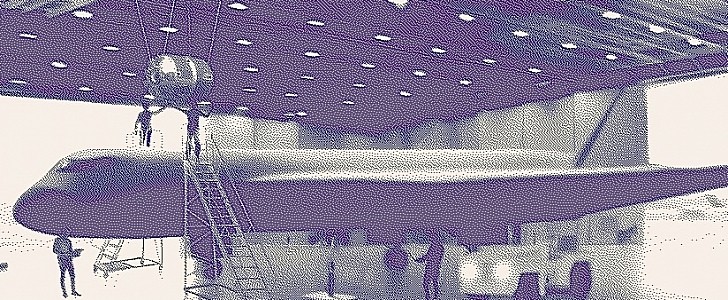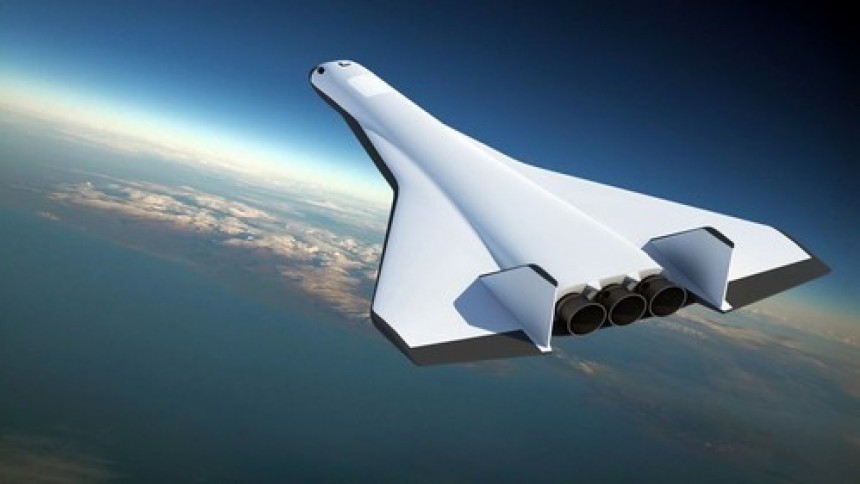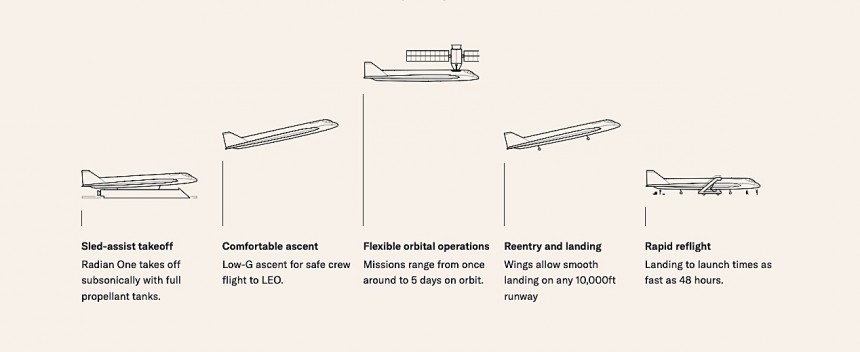“Radian is building the world’s first truly reusable orbital aerospace vehicle.” This is the first thing one reads when landing on Radian Aerospace’s webpage. Don’t know what Radian Aerospace is? Neither did we, until the Radian One came into the spotlight at the beginning of the year. So we started digging, and here’s what we found out so far.
Before we dive into it though, a short recap of how us humans launch stuff into orbit. Presently, there are just two ways we can do that. The first is the traditional way, if you like, using a rocket that launches vertically from a pad. The second involves horizontal rockets and ships, which launch from high-up in the sky, from the underbelly of carrier planes.
There are, of course, at least in theory, other ways of getting off this rock. A very insane one would be a space elevator, just like the one Arthur C. Clarke envisioned in his Fountains of Paradise. Less insane, but not less peculiar, is the idea of using a sort of slingshot to accelerate stuff into orbit, like SpinLaunch is trying to do.
A more down-to-Earth approach would be to use spaceplanes, which can take off pretty much like usual airplanes do, reach orbit, and land just as mundanely when they return. In a nutshell, that’s what Radian Aerospace is trying to do.
The company was set up six years ago in the state of Washington, and is linked to Livingston Holder, a payload specialist who was supposed to fly on the Space Shuttle, but was denied his chance by the Challenger disaster.
Radian's idea is to come up with the “world’s first crewed, single-stage to orbit vehicle with runway-like takeoff and landing.” It’s called Radian One, and it is supposed to “fill the efficiency and capability gaps that exist with traditional vertical rockets.” More to the point, it could carry both cargo and people into orbit, with low cost thanks to its reusability and fast turnaround time.
The One is not yet here, so full details on it are a bit sketchy at the moment, but given all this space exploration hype, it’s worth a closer look, even if only as a means for us to form a general idea about what it is supposed to do.
We said earlier the plane should be able to launch pretty much like usual airplanes do, but that’s only partially correct. Loaded with fuel, it should be accelerated down a runway by means of a sled, probably in an attempt to both preserve the precious substance, and have the plane reach a set speed faster.
It should then slowly climb to low-Earth orbit, which once reached can become One’s home for up to five days. When the mission is completed, it should come down just like the Space Shuttle once did, and it should be capable of touching down on any 10,000 feet (3,000 meters) runway.
Now, pretty much all the technical details on the aircraft are not public at this time, so we do not know what powers it, what fuel it uses, what the fuselage will be made from. But we do know it will be capable of transporting up to 10,000 pounds of cargo (4,500 kg). When the weight is half that, says Radian, the One should be able to place it in orbit in as little as one hour.
Other advantages of this design include the fact that the infrastructure needed to operate it doesn’t need to be as complex as is when it comes to traditional rockets, and the thing can be back on its feet for another mission 48 hours after the previous one ended.
Back in January, Radian announced the completion of a new round of seed funding, and said that up to that point it had been operating in stealth mode. That doesn’t seem to have changed much, as what is above is everything we know so far about the technology.
No mention was ever made about when a working prototype of the One should be ready.
There are, of course, at least in theory, other ways of getting off this rock. A very insane one would be a space elevator, just like the one Arthur C. Clarke envisioned in his Fountains of Paradise. Less insane, but not less peculiar, is the idea of using a sort of slingshot to accelerate stuff into orbit, like SpinLaunch is trying to do.
A more down-to-Earth approach would be to use spaceplanes, which can take off pretty much like usual airplanes do, reach orbit, and land just as mundanely when they return. In a nutshell, that’s what Radian Aerospace is trying to do.
The company was set up six years ago in the state of Washington, and is linked to Livingston Holder, a payload specialist who was supposed to fly on the Space Shuttle, but was denied his chance by the Challenger disaster.
The One is not yet here, so full details on it are a bit sketchy at the moment, but given all this space exploration hype, it’s worth a closer look, even if only as a means for us to form a general idea about what it is supposed to do.
We said earlier the plane should be able to launch pretty much like usual airplanes do, but that’s only partially correct. Loaded with fuel, it should be accelerated down a runway by means of a sled, probably in an attempt to both preserve the precious substance, and have the plane reach a set speed faster.
It should then slowly climb to low-Earth orbit, which once reached can become One’s home for up to five days. When the mission is completed, it should come down just like the Space Shuttle once did, and it should be capable of touching down on any 10,000 feet (3,000 meters) runway.
Other advantages of this design include the fact that the infrastructure needed to operate it doesn’t need to be as complex as is when it comes to traditional rockets, and the thing can be back on its feet for another mission 48 hours after the previous one ended.
Back in January, Radian announced the completion of a new round of seed funding, and said that up to that point it had been operating in stealth mode. That doesn’t seem to have changed much, as what is above is everything we know so far about the technology.
No mention was ever made about when a working prototype of the One should be ready.







